2011 JEEP GRAND CHEROKEE torque
[x] Cancel search: torquePage 384 of 587
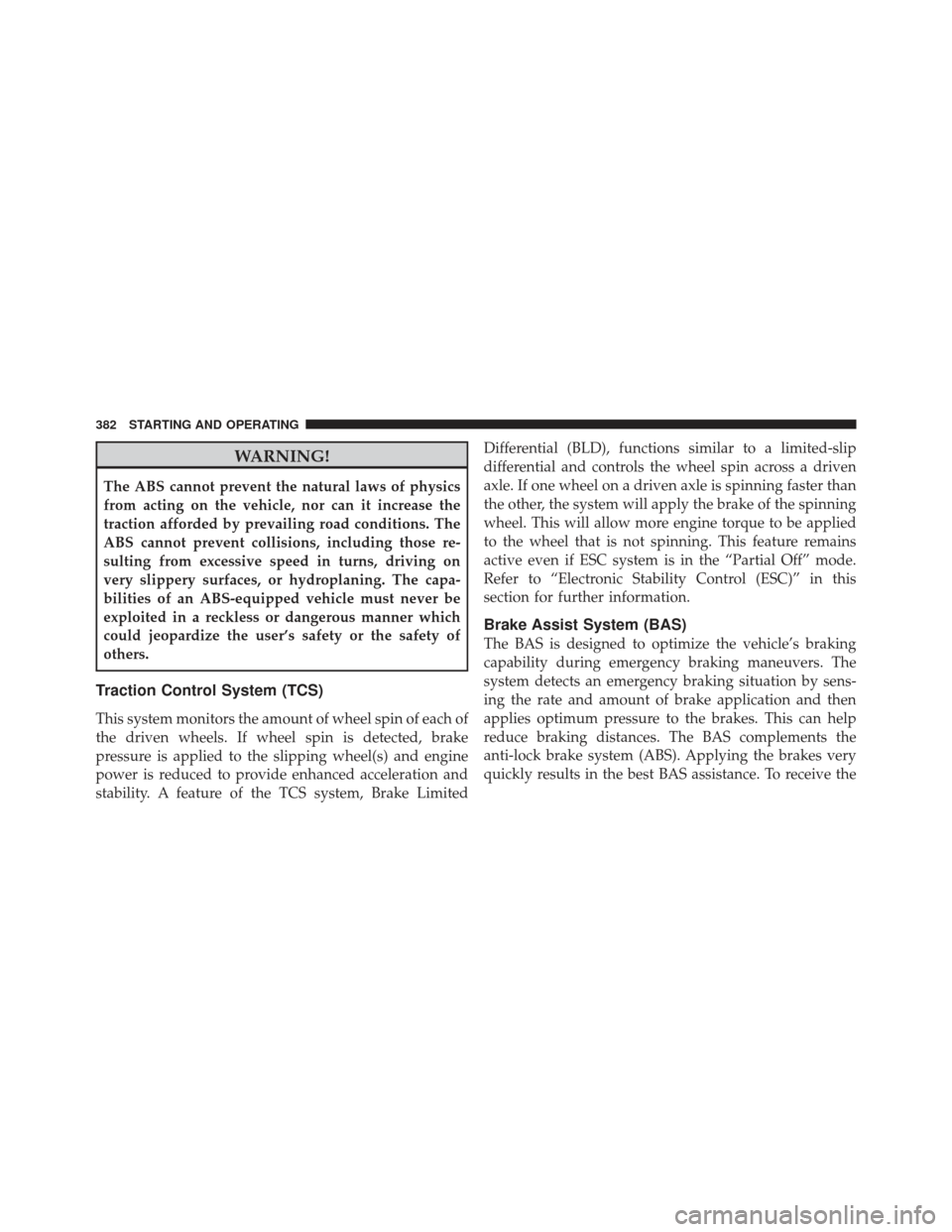
WARNING!
The ABS cannot prevent the natural laws of physics
from acting on the vehicle, nor can it increase the
traction afforded by prevailing road conditions. The
ABS cannot prevent collisions, including those re-
sulting from excessive speed in turns, driving on
very slippery surfaces, or hydroplaning. The capa-
bilities of an ABS-equipped vehicle must never be
exploited in a reckless or dangerous manner which
could jeopardize the user’s safety or the safety of
others.
Traction Control System (TCS)
This system monitors the amount of wheel spin of each of
the driven wheels. If wheel spin is detected, brake
pressure is applied to the slipping wheel(s) and engine
power is reduced to provide enhanced acceleration and
stability. A feature of the TCS system, Brake LimitedDifferential (BLD), functions similar to a limited-slip
differential and controls the wheel spin across a driven
axle. If one wheel on a driven axle is spinning faster than
the other, the system will apply the brake of the spinning
wheel. This will allow more engine torque to be applied
to the wheel that is not spinning. This feature remains
active even if ESC system is in the “Partial Off” mode.
Refer to “Electronic Stability Control (ESC)” in this
section for further information.
Brake Assist System (BAS)
The BAS is designed to optimize the vehicle’s braking
capability during emergency braking maneuvers. The
system detects an emergency braking situation by sens-
ing the rate and amount of brake application and then
applies optimum pressure to the brakes. This can help
reduce braking distances. The BAS complements the
anti-lock brake system (ABS). Applying the brakes very
quickly results in the best BAS assistance. To receive the
382 STARTING AND OPERATING
Page 472 of 587
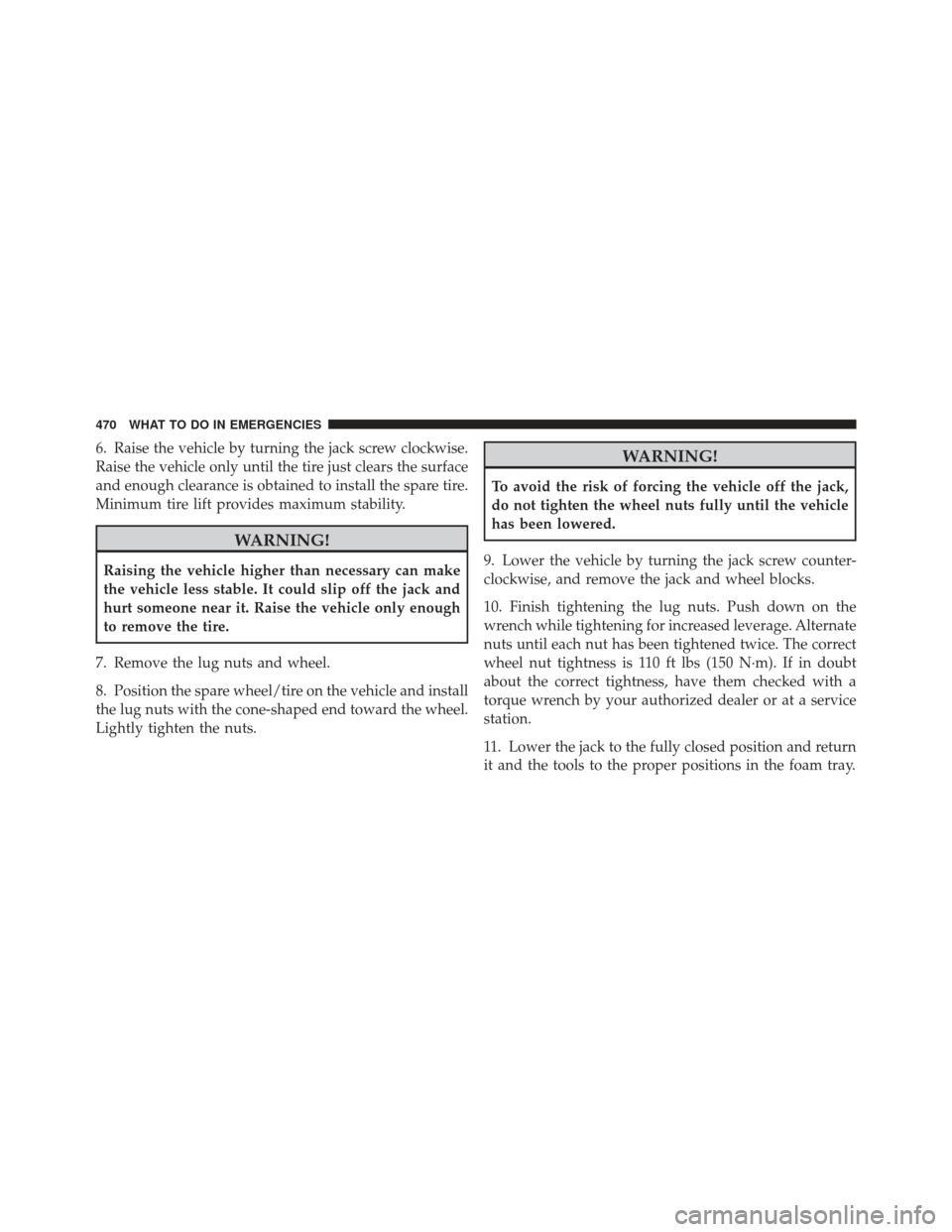
6. Raise the vehicle by turning the jack screw clockwise.
Raise the vehicle only until the tire just clears the surface
and enough clearance is obtained to install the spare tire.
Minimum tire lift provides maximum stability.
WARNING!
Raising the vehicle higher than necessary can make
the vehicle less stable. It could slip off the jack and
hurt someone near it. Raise the vehicle only enough
to remove the tire.
7. Remove the lug nuts and wheel.
8. Position the spare wheel/tire on the vehicle and install
the lug nuts with the cone-shaped end toward the wheel.
Lightly tighten the nuts.
WARNING!
To avoid the risk of forcing the vehicle off the jack,
do not tighten the wheel nuts fully until the vehicle
has been lowered.
9. Lower the vehicle by turning the jack screw counter-
clockwise, and remove the jack and wheel blocks.
10. Finish tightening the lug nuts. Push down on the
wrench while tightening for increased leverage. Alternate
nuts until each nut has been tightened twice. The correct
wheel nut tightness is 110 ft lbs (150 N·m). If in doubt
about the correct tightness, have them checked with a
torque wrench by your authorized dealer or at a service
station.
11. Lower the jack to the fully closed position and return
it and the tools to the proper positions in the foam tray.
470 WHAT TO DO IN EMERGENCIES
Page 473 of 587
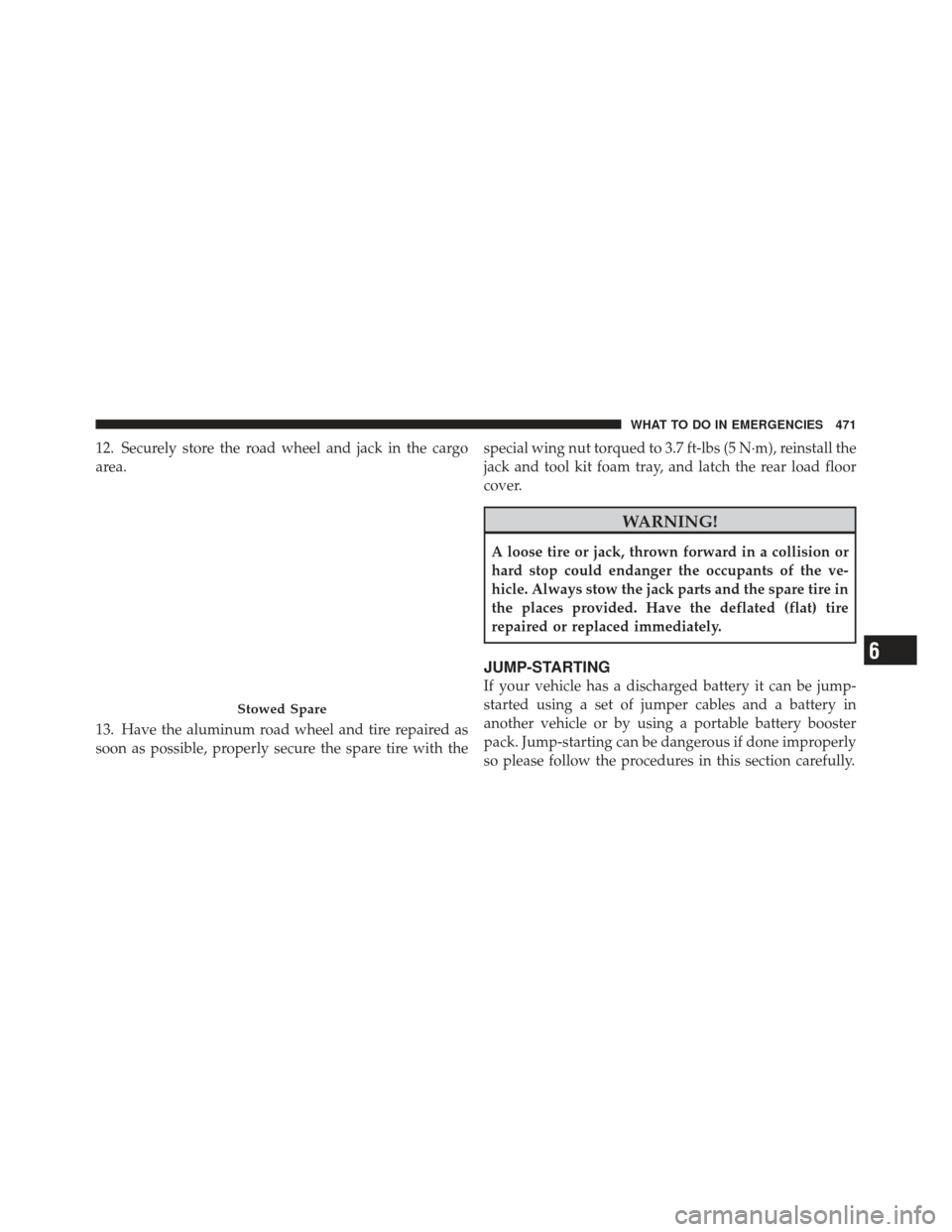
12. Securely store the road wheel and jack in the cargo
area.
13. Have the aluminum road wheel and tire repaired as
soon as possible, properly secure the spare tire with thespecial wing nut torqued to 3.7 ft-lbs (5 N·m), reinstall the
jack and tool kit foam tray, and latch the rear load floor
cover.
WARNING!
A loose tire or jack, thrown forward in a collision or
hard stop could endanger the occupants of the ve-
hicle. Always stow the jack parts and the spare tire in
the places provided. Have the deflated (flat) tire
repaired or replaced immediately.
JUMP-STARTING
If your vehicle has a discharged battery it can be jump-
started using a set of jumper cables and a battery in
another vehicle or by using a portable battery booster
pack. Jump-starting can be dangerous if done improperly
so please follow the procedures in this section carefully.
Stowed Spare
6
WHAT TO DO IN EMERGENCIES 471
Page 513 of 587
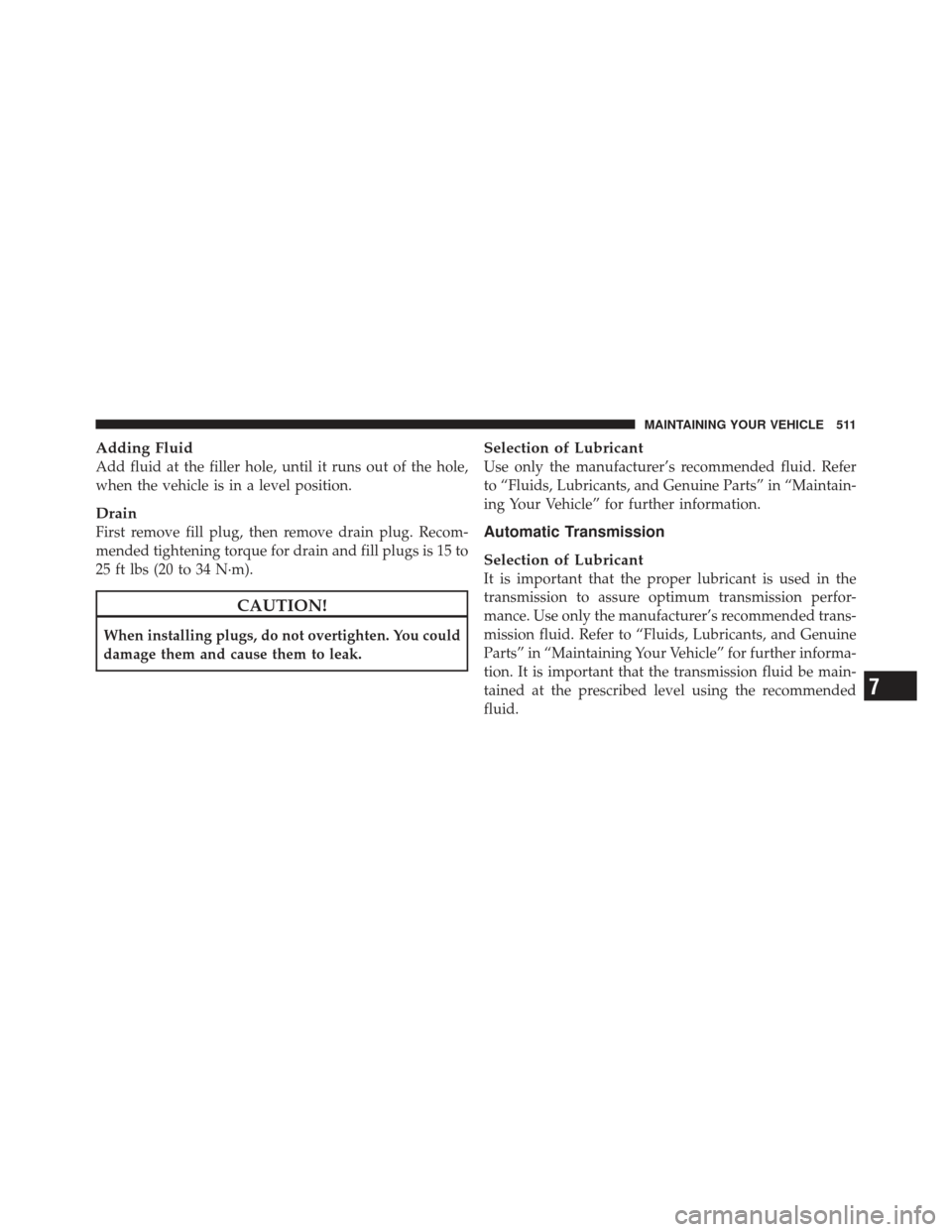
Adding Fluid
Add fluid at the filler hole, until it runs out of the hole,
when the vehicle is in a level position.
Drain
First remove fill plug, then remove drain plug. Recom-
mended tightening torque for drain and fill plugs is 15 to
25 ft lbs (20 to 34 N·m).
CAUTION!
When installing plugs, do not overtighten. You could
damage them and cause them to leak.
Selection of Lubricant
Use only the manufacturer’s recommended fluid. Refer
to “Fluids, Lubricants, and Genuine Parts” in “Maintain-
ing Your Vehicle” for further information.
Automatic Transmission
Selection of Lubricant
It is important that the proper lubricant is used in the
transmission to assure optimum transmission perfor-
mance. Use only the manufacturer’s recommended trans-
mission fluid. Refer to “Fluids, Lubricants, and Genuine
Parts” in “Maintaining Your Vehicle” for further informa-
tion. It is important that the transmission fluid be main-
tained at the prescribed level using the recommended
fluid.
7
MAINTAINING YOUR VEHICLE 511
Page 514 of 587
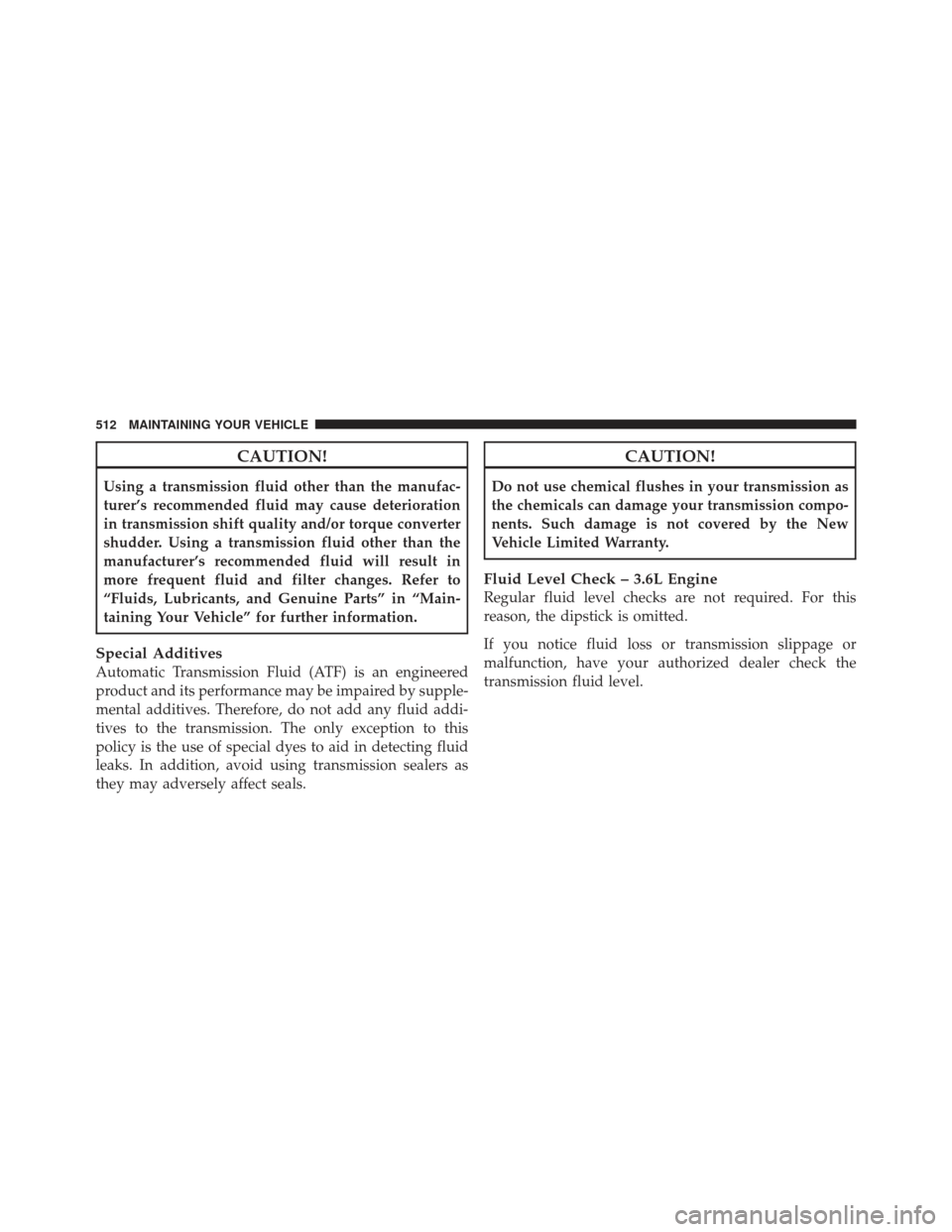
CAUTION!
Using a transmission fluid other than the manufac-
turer’s recommended fluid may cause deterioration
in transmission shift quality and/or torque converter
shudder. Using a transmission fluid other than the
manufacturer’s recommended fluid will result in
more frequent fluid and filter changes. Refer to
“Fluids, Lubricants, and Genuine Parts” in “Main-
taining Your Vehicle” for further information.
Special Additives
Automatic Transmission Fluid (ATF) is an engineered
product and its performance may be impaired by supple-
mental additives. Therefore, do not add any fluid addi-
tives to the transmission. The only exception to this
policy is the use of special dyes to aid in detecting fluid
leaks. In addition, avoid using transmission sealers as
they may adversely affect seals.
CAUTION!
Do not use chemical flushes in your transmission as
the chemicals can damage your transmission compo-
nents. Such damage is not covered by the New
Vehicle Limited Warranty.
Fluid Level Check – 3.6L Engine
Regular fluid level checks are not required. For this
reason, the dipstick is omitted.
If you notice fluid loss or transmission slippage or
malfunction, have your authorized dealer check the
transmission fluid level.
512 MAINTAINING YOUR VEHICLE
Page 515 of 587
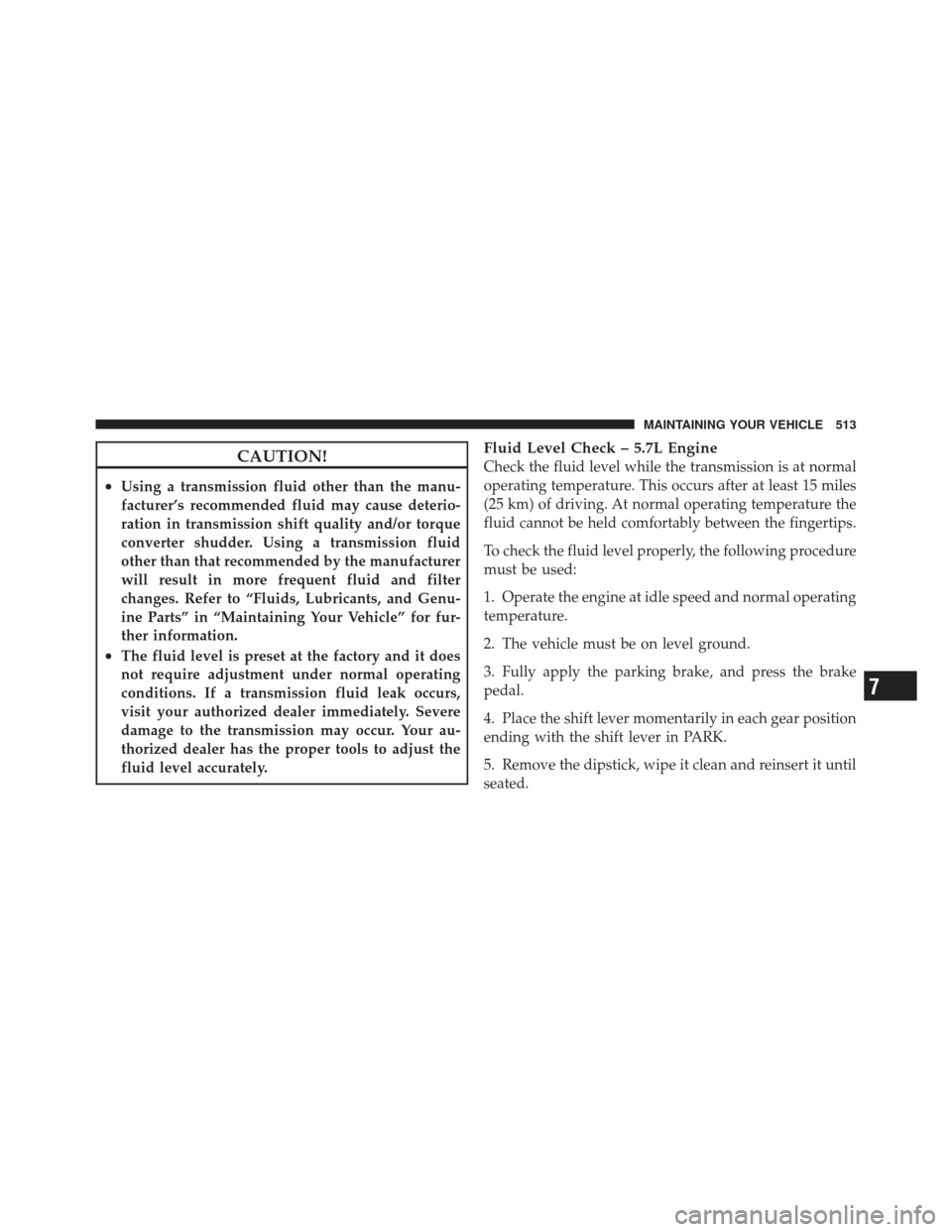
CAUTION!
•Using a transmission fluid other than the manu-
facturer’s recommended fluid may cause deterio-
ration in transmission shift quality and/or torque
converter shudder. Using a transmission fluid
other than that recommended by the manufacturer
will result in more frequent fluid and filter
changes. Refer to “Fluids, Lubricants, and Genu-
ine Parts” in “Maintaining Your Vehicle” for fur-
ther information.
•The fluid level is preset at the factory and it does
not require adjustment under normal operating
conditions. If a transmission fluid leak occurs,
visit your authorized dealer immediately. Severe
damage to the transmission may occur. Your au-
thorized dealer has the proper tools to adjust the
fluid level accurately.
Fluid Level Check – 5.7L Engine
Check the fluid level while the transmission is at normal
operating temperature. This occurs after at least 15 miles
(25 km) of driving. At normal operating temperature the
fluid cannot be held comfortably between the fingertips.
To check the fluid level properly, the following procedure
must be used:
1. Operate the engine at idle speed and normal operating
temperature.
2. The vehicle must be on level ground.
3. Fully apply the parking brake, and press the brake
pedal.
4. Place the shift lever momentarily in each gear position
ending with the shift lever in PARK.
5. Remove the dipstick, wipe it clean and reinsert it until
seated.
7
MAINTAINING YOUR VEHICLE 513
Page 567 of 587
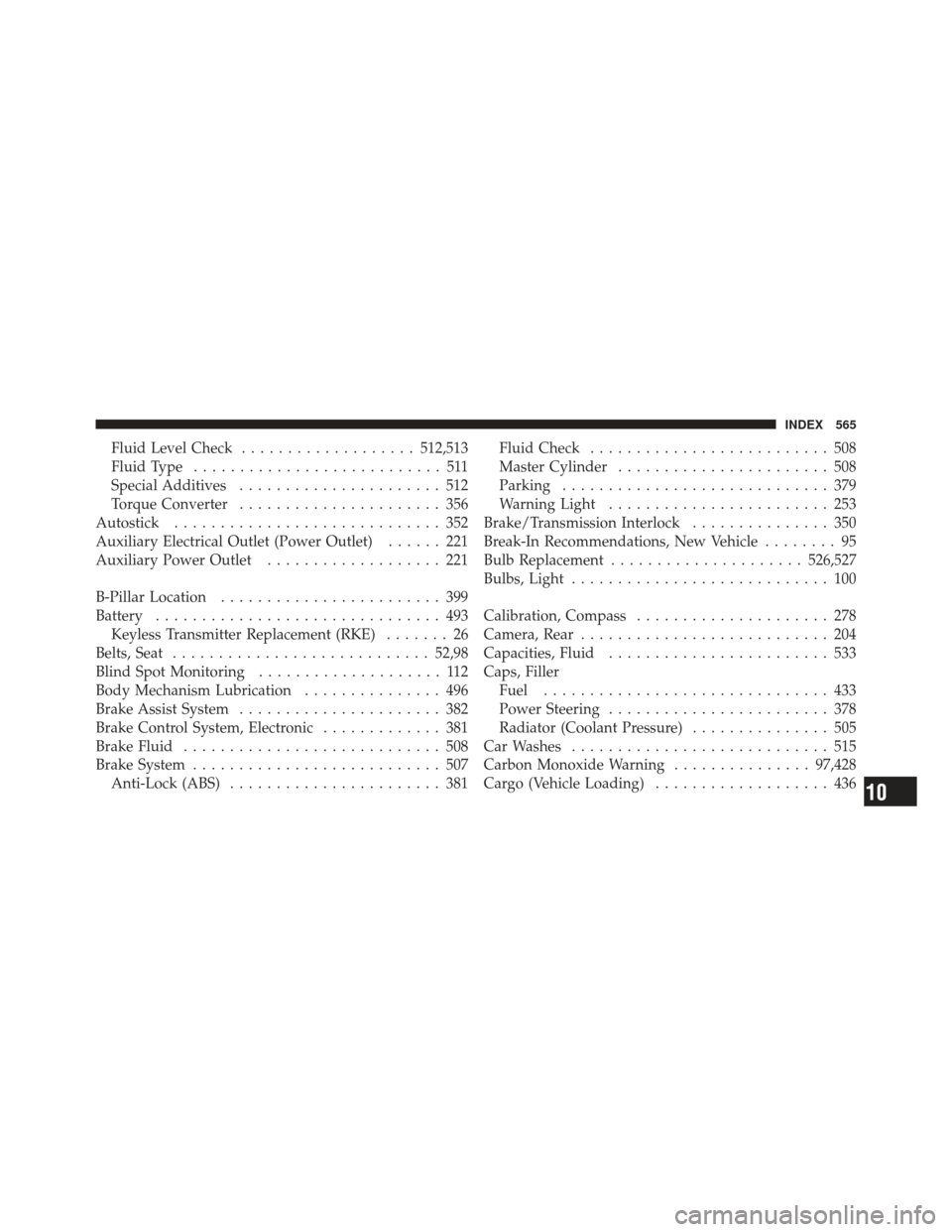
Fluid Level Check................... 512,513
Fluid Type ........................... 511
Special Additives ...................... 512
Torque Converter ...................... 356
Autostick ............................. 352
Auxiliary Electrical Outlet (Power Outlet) ...... 221
Auxiliary Power Outlet ................... 221
B-Pillar Location ........................ 399
Battery ............................... 493
Keyless Transmitter Replacement (RKE) ....... 26
Belts, Seat ............................ 52,98
Blind Spot Monitoring .................... 112
Body Mechanism Lubrication ............... 496
Brake Assist System ...................... 382
Brake Control System, Electronic ............. 381
Brake Fluid ............................ 508
Brake System ........................... 507
Anti-Lock (ABS) ....................... 381 Fluid Check
.......................... 508
Master Cylinder ....................... 508
Parking ............................. 379
Warning Light ........................ 253
Brake/Transmission Interlock ............... 350
Break-In Recommendations, New Vehicle ........ 95
Bulb Replacement ..................... 526,527
Bulbs, Light ............................ 100
Calibration, Compass ..................... 278
Camera, Rear ........................... 204
Capacities, Fluid ........................ 533
Caps, Filler Fuel ............................... 433
Power Steering ........................ 378
Radiator (Coolant Pressure) ............... 505
Car Washes ............................ 515
Carbon Monoxide Warning ...............97,428
Cargo (Vehicle Loading) ................... 436
10
INDEX 565
Page 583 of 587
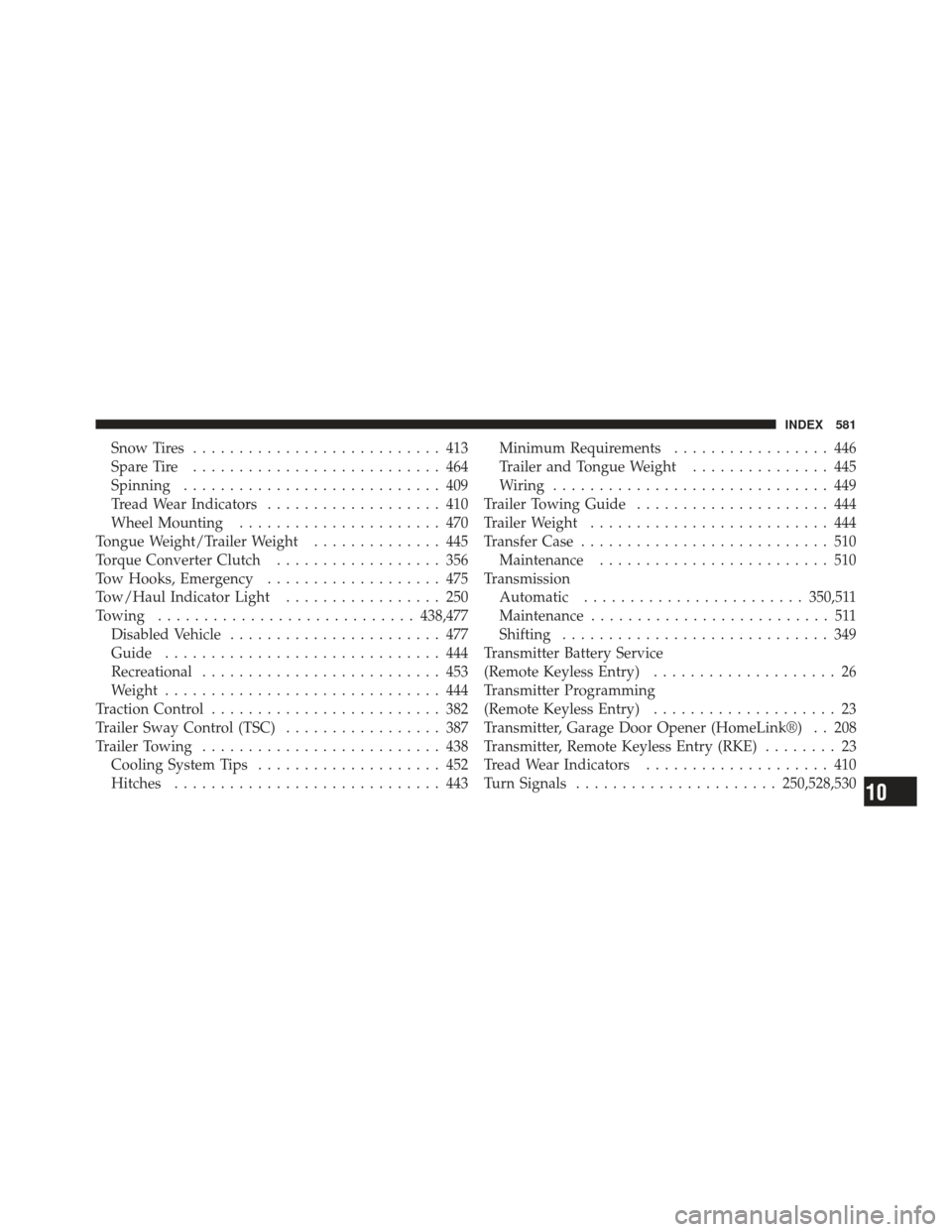
Snow Tires........................... 413
Spare Tire ........................... 464
Spinning ............................ 409
Tread Wear Indicators ................... 410
Wheel Mounting ...................... 470
Tongue Weight/Trailer Weight .............. 445
Torque Converter Clutch .................. 356
Tow Hooks, Emergency ................... 475
Tow/Haul Indicator Light ................. 250
Towing ............................ 438,477
Disabled Vehicle ....................... 477
Guide .............................. 444
Recreational .......................... 453
Weight .............................. 444
Traction Control ......................... 382
Trailer Sway Control (TSC) ................. 387
Trailer Towing .......................... 438
Cooling System Tips .................... 452
Hitches ............................. 443 Minimum Requirements
................. 446
Trailer and Tongue Weight ............... 445
Wiring .............................. 449
Trailer Towing Guide ..................... 444
Trailer Weight .......................... 444
Transfer Case ........................... 510
Maintenance ......................... 510
Transmission Automatic ........................ 350,511
Maintenance .......................... 511
Shifting ............................. 349
Transmitter Battery Service
(Remote Keyless Entry) .................... 26
Transmitter Programming
(Remote Keyless Entry) .................... 23
Transmitter, Garage Door Opener (HomeLink®) . . 208
Transmitter, Remote Keyless Entry (RKE) ........ 23
Tread Wear Indicators .................... 410
Turn Signals ...................... 250,528,530
10
INDEX 581